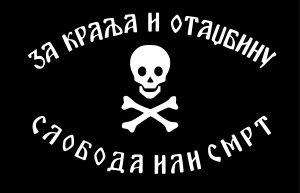Vardar Corps
| Vardar Corps | |
|---|---|
 "For king and fatherland; freedom or death" | |
| Active | ? — the beginning of March 1944 |
| Country |
|
| Allegiance |
|
| Branch | army |
| Role | anti-fascist and anti-communist struggle |
| Size | 1,000 soldiers |
| Engagements | World War II in Yugoslavia |
| Commanders | |
| Commander of the Corp | Stojan Krstić, Captain †[1] |
| Commander of the Kumanovo Brigade | Nikola Janjićijević, Lieutenant |
The Vardar Corps was a corps of the Yugoslav Army in the Homeland (JVuO) that operated on the left bank of the river Vardar during the World War II in Yugoslavia on the territory of modern-day Macedonia and southern Serbia.[2] Its commander was former Captain of the Royal Guard of the Royal Yugoslav Army Stojan Krstić.[3] It consisted of four brigades[4] with total number of 1,000 soldiers.[5] Together with Jablanica Corps, South Morava Corps and Flying Corps it belonged under Mountain Staff 110 (Serbian: Горски Штаб 110) located in Sijarinska Banja which was responsible for the territory of Southern Serbia (which included the territory of contemporary Republic of Macedonia).[6] The four brigades that were components of this Corps were:
- Kumanovo (or Žegligovo) Brigade
- Ristovac Brigade
- Preševo Brigade
- Kriva Palanka Brigade
The commander of Kumanovo Brigade was Lieutenant Nikola Janjićijević.[7]
The territory in which this Corps operated was triangle between Gnjilane, Vranje and Veles which belonged to the former Yugoslav counties of Preševo, Kriva Palanka, Kumanovo, Ovče Polje and Skoplje.[8]
The Vardar Corps was destroyed by Partisan units from Macedonia and Serbia at the beginning of March 1944.[9]
References
- ↑ (Pettibone 2014, p. 389)
- ↑ (Muzej 1965, p. 138): "Вардарски четнички корпус формиран је и деловао је на левој обали Вардара, са ослонцем на Скопску Црну Гору. "
- ↑ (Muzej 1965, p. 138): "Командант корпуса био је капетан II класе краљеве гарде бнвше југословенске војске Стојан С. Крстић"
- ↑ (MANU 1973, p. 600)
- ↑ (Apostolski 1980, p. 78):" ... „Вардарски четнички корпус" од неколку бригади — во вкупна јачина од околу 1.000 луѓе."
- ↑ 36. НОР, том I, књ. 20. док. 141, page 134
- ↑ (Muzej 1986, p. 39)
- ↑ (MANU 1973, p. 590): "Вардарски четнички корпус обухватао је тернторију прешевског, кривопаланачког, жеглиговског (кумановског), овчепољског и скопског среза, односно, углавном територију огранпчену линијом: Врање — Гњилане — Велес"
- ↑ (MANU 1973, p. 600)
Sources
- Muzej (1965). Leskovac̆ki zbornik. Narodni muzej u Leskovcu.
- Apostolski, Mihailo (1980). Pogledi vrz jugoslovensko-bugarskite odnosi vo vtorata svetska vojna (in Macedonian). Naša kniga.
- MANU (1973). Simpozium Razvojot i karakteristikite na narodnooslboditelnata vojna i na revolucijata vo Makedonija: Skopje, 9-10 dekemvri 1971 godina. Makedonska akademija na naukite i umetnostite i Institut za nacjonalna istorija.
- Muzej (1986). Vranjski glasnik. Narodni muzej u Vranju.
- Pettibone, Charles D. (April 2014). THE ORGANIZATION AND ORDER OF BATTLE OF MILITARIES IN WORLD WAR II. Trafford Publishing. ISBN 978-1-4907-3386-9.